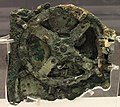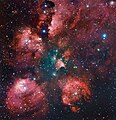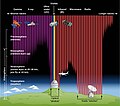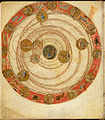Portal:Astronomy
|
The Astronomy Portal
Introduction Astronomy is a natural science that studies celestial objects and the phenomena that occur in the cosmos. It uses mathematics, physics, and chemistry in order to explain their origin and their overall evolution. Objects of interest include planets, moons, stars, nebulae, galaxies, meteoroids, asteroids, and comets. Relevant phenomena include supernova explosions, gamma ray bursts, quasars, blazars, pulsars, and cosmic microwave background radiation. More generally, astronomy studies everything that originates beyond Earth's atmosphere. Cosmology is a branch of astronomy that studies the universe as a whole. Astronomy is one of the oldest natural sciences. The early civilizations in recorded history made methodical observations of the night sky. These include the Egyptians, Babylonians, Greeks, Indians, Chinese, Maya, and many ancient indigenous peoples of the Americas. In the past, astronomy included disciplines as diverse as astrometry, celestial navigation, observational astronomy, and the making of calendars. Professional astronomy is split into observational and theoretical branches. Observational astronomy is focused on acquiring data from observations of astronomical objects. This data is then analyzed using basic principles of physics. Theoretical astronomy is oriented toward the development of computer or analytical models to describe astronomical objects and phenomena. These two fields complement each other. Theoretical astronomy seeks to explain observational results and observations are used to confirm theoretical results. Astronomy is one of the few sciences in which amateurs play an active role. This is especially true for the discovery and observation of transient events. Amateur astronomers have helped with many important discoveries, such as finding new comets. (Full article...) General images -The following are images from various astronomy-related articles on Wikipedia.
This is a Featured article, which represents some of the best content on English Wikipedia.
 Comet Shoemaker–Levy 9 (formally designated D/1993 F2) was a comet that broke apart in July 1992 and collided with Jupiter in July 1994, providing the first direct observation of an extraterrestrial collision of Solar System objects. This generated a large amount of coverage in the popular media, and the comet was closely observed by astronomers worldwide. The collision provided new information about Jupiter and highlighted its possible role in reducing space debris in the inner Solar System. The comet was discovered by astronomers Carolyn and Eugene M. Shoemaker, and David Levy in 1993. Shoemaker–Levy 9 (SL9) had been captured by Jupiter and was orbiting the planet at the time. It was located on the night of March 24 in a photograph taken with the 46 cm (18 in) Schmidt telescope at the Palomar Observatory in California. It was the first active comet observed to be orbiting a planet, and had probably been captured by Jupiter around 20 to 30 years earlier. (Full article...) Did you know -
More Did you know (auto generated)
WikiProjectsSelected image - HD 28527 is a star in the constellation Taurus, and a member of the Hyades open cluster. It is faintly visible to the naked eye with an apparent visual magnitude of 4.78. The distance to this star, as determined from its parallax shift of 22 mas, is 148 light years. Astronomy News
November anniversaries
Space-related PortalsAstronomical eventsAll times UT unless otherwise specified. Portal:Astronomy/Events/November 2024 TopicsSubcategoriesSelect [►] to view subcategories
Things you can do
WikibooksThese books may be in various stages of development. See also the related Science and Mathematics bookshelves.
WikijuniorAssociated WikimediaThe following Wikimedia Foundation sister projects provide more on this subject:
Discover Wikipedia using portals Shortcuts to this page: Astronomy portal • P:ASTRO Purge server cache |





























































